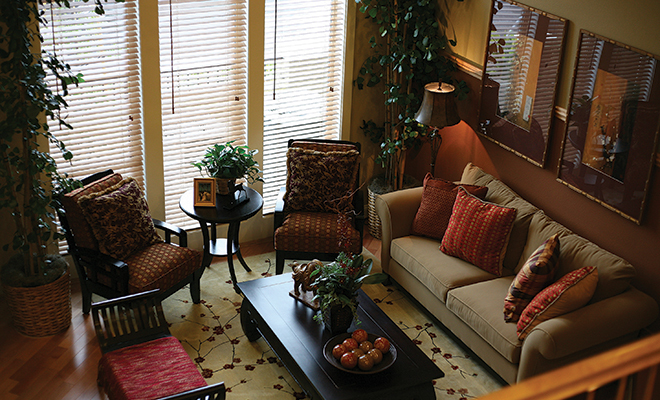
Live Large in Your Small Space
Small-space living doesn’t mean you need to scrimp on style or furniture. Instead, it’s about keeping modern and functional solutions in mind when it comes to decorating a space with less square footage. Whether you’re just starting out in your first apartment or downsizing to a modern, minimized house now that the kids are grown up and gone, there are a few tricks to maximize and make the most of your smaller space.
Think vertically! When you don’t have the space to go around, go up instead. Tall bookshelves or cabinets give you the storage space you need without taking up your elbow room. High-reaching furniture pieces will draw eyes upward and also help create visual interest in your space. Choosing to commit to a floor-to-ceiling solution is a great opportunity for you to go custom; investing in built-ins or a small renovation could save you money (and headaches!) in the long run by creating a lasting solution that works, instead of looking for a quick fix every few months. If a built-in or larger structure isn’t an option, wall shelving can be an equally successful solution. Shelves can be placed strategically on your walls, climbing upward, to save space. Place canisters or other organizational items on shelves to keep things such as letters, bills and magazines off the counter. Shelves are also a great place for plants, adding greenery to the room without taking up table space.
Dark paint colors or busy wallpaper can make a space feel smaller and more constricting than it actually is. To diffuse this feeling, opt for lighter tones that you can carry through the whole space instead of making a clear color division between rooms. This will help make the space appear larger, and the consistency among light colors creates a calm balance throughout. It also reflects light more easily, brightening your room even more. Adding mirrors to your walls will bring in light, too. Mirrors are a relatively inexpensive way to create the illusion of more space while simultaneously acting as a beautiful accent. Using a reflective material such as glass is also a smart substitution for any wood or steel. A coffee table with a glass top, for example, keeps a room looking more open than a solid wood table.
Downsizing or living in a smaller space also asks you to be a bit of a curator and editor. Because there’s less room to work with, consider becoming extra particular in the accessories and pieces you choose to display and have in your home. This is a great opportunity for you to determine which items matter to you most. It’s also a chance to get creative with your displays. If you have a large collection of items, consider snapping a few photos and creating either a gallery wall or collage instead of finding room for individual items.
A key tip: tiny space doesn’t always call for tiny furniture. A mid-size sectional could be a better scale for your room rather than a sofa and an accent chair, even if they have smaller footprints. Think about how you’re going to use the room. Is it easier to have one larger piece of furniture or multiple smaller pieces that you’ll have to maneuver around? When decorating any space, make sure you spend some time with it before making any big decisions or purchases. It will help you understand how you use the room and what pieces will be best suited for it. And in doing this, you may find a particular room is multi-purposeful.
Tossing any visual barriers to the wayside can improve the layout of your space. Hanging your television on a wall instead of placing it in a bulky media cabinet or entertainment unit, for example, is an easy way to declutter that area of your space. And other times, adapting to less square footage isn’t about giving up entire furniture pieces but simply choosing a different version. You can still get the king-size bed but maybe not the tall headboard. The island in your kitchen may have to be a more standard shape instead of an all-encompassing U-shape. The dinner table you choose might have to double as the breakfast spot or be functional enough to host more formal meal gatherings.
Other general recommendations include avoiding bold patterns or overly obtrusive furniture. The design and scale of certain furniture pieces can be overwhelming in smaller spaces. Solid colors are best for larger pieces, but let bright hues and personality come to life with artwork and throw pillows or blankets. Artwork that features vertical lines is also a great addition to a small space, especially if you’re dealing with low ceilings. Hang the pieces above eye-level to create the illusion of higher ceilings. HLM
Sources: bhg.com, hgtv.com, home.howstuffworks.com, housebeautiful.com, realsimple.com, styleathome.com and thisoldhouse.com.







